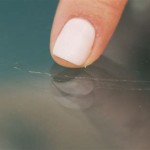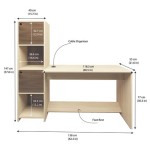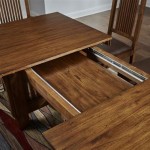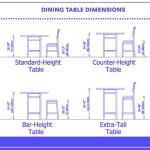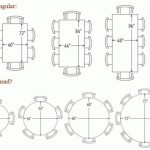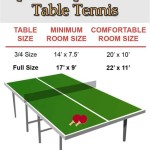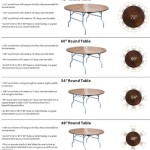Instead, let the reader draw their own conclusions based on the information provided.
Dining Room Tables with Extension Leaves: Maximizing Space and Functionality
Dining room tables with extension leaves offer a versatile solution for homeowners seeking to balance everyday practicality with the need to accommodate larger gatherings. These tables are designed with built-in mechanisms allowing them to expand in size, providing additional seating when required while maintaining a smaller footprint during regular use. The inclusion of extension leaves makes them a popular choice for individuals and families who frequently entertain or anticipate occasional large dinner parties but do not want a permanently oversized table occupying their dining space.
The design and construction of dining room tables with extension leaves vary widely, encompassing different materials, styles, and extension mechanisms. Understanding these variations is crucial when selecting a table that meets both aesthetic preferences and functional requirements. The longevity and ease of use inherent to a table depend heavily on these factors. This article explores the types of extension leaves, the mechanisms involved, and the material considerations pertinent to these versatile pieces of furniture.
Types of Extension Leaves
Several types of extension leaves are commonly incorporated into dining table designs. Each type offers a unique approach to expanding the table's surface area, impacting the table's overall appearance and ease of use. The choice of extension leaf type often depends on the size of the table, the desired aesthetic, and the frequency with which the table will be extended.
Butterfly Leaves are hinged in the center and fold beneath the tabletop when not needed. To extend the table, the tabletop is typically split in the middle, allowing the butterfly leaf to swing up and into place. This type of leaf is convenient because it is stored within the table itself, eliminating the need for separate storage. However, butterfly leaves are often limited in the amount of additional space they provide, making them better suited for smaller tables or those requiring only a modest increase in seating capacity.
Drop-in Leaves, also known as insert leaves, are separate pieces that are added to the center of the table when it is extended. The tabletop is split, and the two halves are pulled apart to create space for the leaf. These leaves are typically stored separately when not in use. Drop-in leaves offer greater flexibility in terms of the amount of additional space they can provide. Multiple leaves can often be added to a single table, allowing for significant increases in seating capacity. However, the need for separate storage and the potential for mismatched finishes due to environmental factors can be drawbacks.
Self-Storing Leaves are similar to drop-in leaves but are designed to be stored within the table itself, often in a compartment beneath the tabletop. This eliminates the need for separate storage while still providing the flexibility of drop-in leaves. Self-storing leaves are a practical option for those seeking convenience and space-saving solutions. The mechanism for storing and retrieving the leaves must be robust and reliable to ensure long-term functionality.
Draw Leaves, also known as flip leaves, are concealed beneath the tabletop at each end of the table. To extend the table, the leaves are pulled out from underneath and flipped up into place, supported by a mechanism. Draw leaves offer a seamless extension that integrates well with the table's design. They are particularly suitable for tables where aesthetics are a primary concern, as the leaves are virtually invisible when not in use. However, the size of the draw leaves is often limited by the dimensions of the table's frame.
Extension Mechanisms
The effectiveness of a dining room table with extension leaves hinges on the reliability and smoothness of its extension mechanism. A well-designed mechanism ensures that the table can be easily extended and retracted, providing a stable and secure surface for dining. The type of mechanism employed will influence the table's cost, durability, and ease of use.
Geared Slides are a common mechanism used in tables with drop-in leaves and self-storing leaves. These slides consist of interlocking gears that ensure the two halves of the tabletop move apart smoothly and evenly. The gears distribute the force required to extend the table, making it easier to operate, especially on larger tables. Geared slides are generally considered to be durable and reliable, providing long-term functionality.
Wooden Slides are a more traditional mechanism, often found in antique or handcrafted tables. These slides rely on carefully fitted wooden runners that allow the tabletop to slide apart. While wooden slides can be aesthetically pleasing, they are more susceptible to wear and tear than geared slides. Changes in humidity can cause the wood to swell or shrink, affecting the smoothness of the mechanism. Regular maintenance and lubrication are often required to keep wooden slides functioning properly.
Cable Extension Systems use a cable to synchronize the movement of the tabletop halves. As one side of the table is pulled, the cable pulls the other side along with it, ensuring that the gap for the extension leaf is created evenly. Cable extension systems are often used in modern table designs and can be very smooth and efficient. However, the cables can be susceptible to stretching or fraying over time, requiring occasional replacement.
Telescoping Slides are another option, where one section of the table slides within another. These are commonly used in tables with butterfly leaves or draw leaves, where the leaf is stored beneath the tabletop. Telescoping slides need to be strong and stable to support the weight of the leaf and the tabletop. The quality of the slides directly impacts the ease and smoothness of the extension process.
Material Considerations
The materials used in the construction of a dining room table with extension leaves significantly impact its appearance, durability, and maintenance requirements. Different materials offer varying levels of resistance to scratches, stains, and warping, influencing the table's suitability for different lifestyles and environments. The choice of material also affects the overall aesthetic of the table, contributing to the style and ambiance of the dining room.
Solid Wood is a classic choice for dining tables, prized for its natural beauty, strength, and durability. Tables made from solid wood can last for generations with proper care. Different types of wood offer varying levels of hardness, grain patterns, and color tones. Hardwoods like oak, maple, and cherry are popular choices for their resistance to dents and scratches. Solid wood tables can be more expensive than those made from other materials, but their longevity and timeless appeal often justify the investment. Consideration must be given to the wood's tendency to expand and contract with changes in humidity, potentially impacting the extension mechanism's performance.
Veneered Wood consists of a thin layer of wood applied to a core of less expensive material, such as plywood or particleboard. Veneered wood tables offer the look of solid wood at a more affordable price. Veneer can also be used to create intricate patterns or designs that would be difficult to achieve with solid wood. However, veneered wood is more susceptible to damage than solid wood. The veneer can chip or peel if exposed to excessive moisture or impact. Careful handling and maintenance are essential to preserve the appearance of a veneered table.
Glass tabletops offer a sleek and modern aesthetic. Glass is easy to clean and resistant to stains, making it a practical choice for families with young children. However, glass can be prone to scratches and can shatter if subjected to significant impact. Tempered glass is a stronger and more durable option, but it is still susceptible to damage. Extension leaves on glass tables often consist of glass or a complementary material, such as wood or metal. The mechanism for extending a glass table must be carefully designed to ensure stability and prevent damage to the glass.
Metal is often used for the base and legs of dining tables with extension leaves, providing strength and stability. Metal bases can be paired with tabletops made from wood, glass, or other materials. Metal is durable and resistant to rust and corrosion, making it a good choice for high-traffic areas. However, metal can be cold to the touch and may not be as aesthetically pleasing as other materials to some individuals. Powder-coated metal finishes offer a durable and attractive alternative to traditional paint finishes.
Laminate is a synthetic material that is often used as a surface covering for dining tables. Laminate is affordable, easy to clean, and resistant to scratches and stains. It is available in a wide range of colors and patterns, allowing for versatility in design. However, laminate is not as durable as solid wood or veneer and can be prone to chipping or peeling. It also lacks the natural beauty and warmth of wood. Laminate tables are a budget-friendly option for those seeking a practical and low-maintenance dining surface.

Extendable Dining Tables With Leaves Solid Wood Amish

Grainvalley Drawleaf Extension Dining Table From Dutchcrafters Amish

Diy Farmhouse Table With Extension Leaves Plans Sweet Tooth Life

Rustic Extendable 75 94 Dining Table Peter Andrews

Extendable Dining Tables With Leaves Solid Wood Amish

Leaves And Extensions Jeffrey Greene

Walnut Extendable Table Expandable Dining With 2 Leaves Extending Room

Kraven 72 Dining Table With Extension Leaf Dark Hazelnut Com

5ft To 8ft Extendable End Leaf Farmhouse Dining Set Furniture

Copeland Furniture Natural Hardwood From Vermont Exeter Double Leaf Extension Table In Walnut


